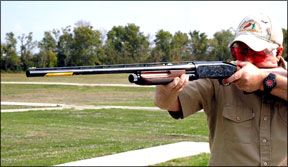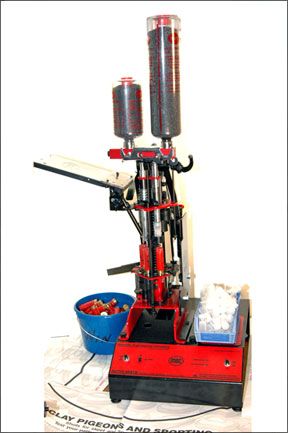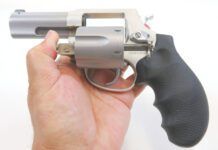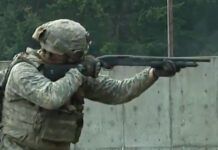Of all the clay-shooting sports, the game of trap is perhaps the least understood. But the concept is simple. Target presentation is based on the taking of a bird as if it were flushed from the ground. The name trap was taken from the original mechanism, which was as simple as releasing a live bird from a box or trap placed on the ground. The practice of using live birds then gave way to tossing glass balls as targets. (We pity the persons who were charged with cleaning up the broken glass.) According to the Krause publication, the Gun Digest Book of Trap and Skeet Shooting by Christian and Sapp, the glass targets were replaced with clay “birds” some time in the 1880s. Today, the clay birds are thrown by machine. A voice-operated release system that responds to the shooters verbal command is the latest innovation.

Trap is great practice for the upland hunter. But it is also a fast-action quick-draw game. The powerful pattern of the 12-gauge shotgun is preferred because the targets move quickly into the distance. An important characteristic of a trap shotgun is that it delivers a pattern higher than the point of aim. This helps compensate for a target that is rising quickly, but it also helps when the target is falling.
Two features are generally relied upon to deliver a pattern higher than point of aim: A higher rib and a higher comb. A common sight picture on a trap gun is the front bead stacked above a second bead located midway down the rib. Without the presence of a mid-bead, the rib will likely appear as a ramp.
To visit a big trap match and look at the competitors guns can be as enthralling as attending a custom car show. But a $10K over/under is not a necessity. Nor are some of the radical modifications to the guns one might see on match day.
In this test we will evaluate three trap shotguns designed to put you into the action for much less money than even we expected. In looking for a suitable trap gun, we found that pump-action models were the most economical. We chose two. They were the Ithaca Model 37 Trap FL3712-30BTR, $995; and the Browning BPS Micro Trap 012241404, $759. Each of these guns were bottom-eject models, contributing to their appeal to both right- and left-handed shooters. In addition, we came across a single-barrel break-action model from Harrington & Richardson. This was the Topper Trap shotgun SB1-30T, $360, so we decided to give it a try.
In preparation for this test we pored through dozens of instructional videos old and new. The most complete explanation and demonstration we found was on a new DVD entitled Perfect Trap ($69, from championvideosonline.com). Perfect Trap uses modern technology to put the viewer behind the gun and shows you what to look for before and after you call for the bird. The instructors are champion clay target shooters Ed Arrighi and Dan Carlisle. Their instruction demonstrates a wealth of knowledge not only about shooting trap but also how to coach a variety of shooters. After learning that Ed Arrighi had set up shop at American Shooting Centers in Houston (amshootcenters.com), we booked a few lessons before beginning our evaluation. We can attest that the coaching of Ed Arrighi opened our eyes to better evaluate each shotgun and significantly raise our scores.
In trap singles competition, a single clay bird is launched from the trap house at random direction and trajectory with the shooter standing at one of five positions located 16 yards behind the point of release. The five positions are arranged in a semi-circle roughly approximating the arc between 8 oclock and 4 oclock. Figuring that by the time an average shooter sees the bird and fires a shot, the clay has likely traveled about 9 yards, we decided to pattern our guns from a distance of 25 yards. Each gun was patterned with the supplied choke we felt would be the most popular choice for shooting a round of trap. Our patterning test rounds were a popular budget-price round, a popular match-grade round, and a match-grade handload featuring AA hulls, Alliant Green Dot powder, and Remington STS primers. The budget round was the Estate Super Sport Competition Target SS12L8 load. The factory match round was Winchester AA Light Target Load AA128. Our handload was constructed using a MEC 9000E. The 9000E is a progressive loader that uses an electric motor to drive the press ($899 from Trainer Hale Supply, 830-420-4530). All three rounds were 23⁄4-inch 11⁄8-ounce 23⁄4-dram equivalent charges behind No. 8 shot. For our handloads, we used magnum quality shot because the BBs are harder and less likely to deform as they speed down the barrel. Each of our test guns were sold as right-handed models so we patterned from the right-side shoulder. But we contested on the trap field with both right- and left-handed shooters. How high did each gun score? Lets call “Pull!” and find out.
Ithaca Model 37 Trap FL3712-30BTR
3-Inch 12 Gauge, $995
Most people think of pump shotguns as being utilitarian and tool-like in function and appearance. But when we first encountered the Ithaca Model 37 Trap, we found its appearance to be rich and intriguing. The barrel, marked “Featherlight,” was topped with a high 0.4-inch-wide ventilated rib that featured a brass bead at the muzzle, a white mid-bead, and grooved surface to kill glare. About midway along the underside of the barrel was a lug that reminded us of a lug for a bayonet. This played a part in seating the barrel. Fitting the barrel to the action required turning the barrel into the receiver and aligning the lug with the end of the magazine. The

magazine cap was then rotated counter clockwise to move it forward until it sat firmly against the barrel lug. Magazine capacity was four rounds, and there was a spring-loaded tab accessible through the ejection port that acted as a shell stop. Pressing it to the side allowed for the magazine to be unloaded without working the slide.
The next distinct feature was the abbreviated fore end slide connected to a single action bar. The bar was on the left side and its construction was large and sturdy. The slide itself was only about 5.5 inches long but surrounded by generously checkered walnut. The receiver was blued and modestly engraved with a different duck-hunting scene on each side. The upper left corner of the trigger guard showed a crossbolt safety, and the trigger was gold in color. The walnut stock was just short of spectacular in grain and well above what we would expect for a shotgun in this price range. The pistol grip was covered with checkering on each side. The butt of the pistol grip was capped with an Ithaca logo. The dimension of the pistol grip was excellent, our team said. There was a palm relief where the comb met the top of the pistol grip, and this helped make the gun ambidextrous. Indeed, cast was very small. Much of the favoritism towards the right-handed shooter was achieved by keeping the cheek side of the stock somewhat flat. In comparison, our left-handed shooter felt the right side of the stock was noticeably rounder.
The comb on the Model 37 was raised in a Monte Carlo profile, and the buttpad was quite soft, extending the length of pull to about 14.2 inches. We measured trigger pull to be about 7 pounds. Supplied chokes were Full, Modified and Improved Cylinder.
Our first trip to the pattern board was with the Full choke in place. We used Hunter John targets that featured a 3.75-inch dot in the center. Aiming at 6 oclock beneath the dot, we found that the Ithaca consistently printed about 70% of its hits above point of aim. Our handload showed the greatest density within a 13-inch circle. Both the Estate and Winchester AA rounds delivered a primary pattern that measured about 17 inches in diameter at 25 yards. But the AA hits were denser, and there were few, if any, stray hits outside of its circular shape. After a few rounds of trap we found that the Ithaca provided such a dense pattern that we decided we could use a Modified choke instead of the Full. Returning to the pattern board, we fired with the Modified choke in place. The most significant differences between chokes was found when we fired our handloads and the Winchester AA ammunition. The handloads were noticeably denser in the center than before, with the overall pattern growing only about 2 to 3 inches in diameter. The Winchester AA pattern covered more than 20 inches. Density faded at the perimeter, but it was pleasing to note that the hits were evenly spaced nonetheless.
Operationally, the Ithaca had its preferences. When firing less expensive rounds, feeding could be balky. We even had a few instances when the hull refused to eject. But we never had any difficulty with rounds such as the Winchester AA or Remington STS. Our handloads also glided right through the Ithaca. In fact, with any one of a number of favorable rounds, the Ithaca Model 37 pump was a rocket ship. Its fast action came in handy when firing doubles or when shooting Wobble Trap, wherein second shots on a single target are permitted.
When competing in the trap singles event, only one shell at a time is allowed to be loaded. For a pump gun this means a single shell can be loaded into the magazine and then cycled into the chamber or, the shooter can load directly through the loading gate. Chambering a round manually through the loading gate required turning the gun upside down and laying the round on top of the carrier. We found that the remainder of the process was best performed in two steps. Step one was to lower the round to align with the chamber. Allowing the round to settle, step two was to move the slide forward. Trying to do this all in one motion was sometimes difficult. Ultimately, we found it far less trouble to place the round into the magazine and simply rack the slide.
There were three additional characteristics of the Ithaca Model 37 Trap we should point out. The crossbolt safety travels quite a bit and protrudes boldly from the left-hand side when in the off-Safe position. This could interfere with the trigger finger of the left-handed shooter. Otherwise, the gun was neutral for the lefty or righty.
Initially, we had a problem with the slide release. Actually, it worked fine. But in looking at the way the contact surface was designed, we found it was easy to misread. It looked like it should be pushed straight to the rear. That didnt work. The proper motion was to rotate the lever downward in a brief clockwise arc.
Last, at its present length of pull, some shooters will not be able to fully grip the abbreviated fore end. But this didnt seem to bother anyone on our staff. The gun pointed easily and we felt confident of breaking the target each time we fired.
Our Team Said: The Ithaca Model 37 strikes us as a very good value. Quality wood, solid construction and a properly machined barrel add up to a shotgun of sophisticated appearance and formidable performance. The Model 37 Trap is perhaps the most handsome pump shotgun Ithaca has ever produced. The wood is exceptional, and it can be operated very quickly despite a smallish fore end. Patterns were strong and consistent, which we think was evidence of a superior barrel. But it did have its preferences and was balky with a few brands of ammunition we tried.
Browning BPS Micro Trap 012241404
3-Inch 12 Gauge, $759
In the process of acquiring a Browning Pump Shotgun, or BPS for short, we learned that the full-size BPS Trap was temporarily out of stock. So we settled for the Micro Trap, a so-called youth model. We decided that the Micro Trap was indeed suitable because the only differences were barrel length (28 inches versus 30 inches), and a shorter length of pull. Reducing length of pull is undoubtedly the most popular modification applied to a shotgun. So, to our way of thinking, we were getting a freebie rather than a penalty. On many youth models the distance top to bottom at the butt end (from heel to toe) is reduced. This reduction in contact area can increase the sensation of felt recoil. But the buttstock on our Micro was full profile. Both Browning Trap models were chambered for 2-inch rounds. Our choice of he Micro Trap should not be seen as a compromise.
The buttstock of the Micro Trap displayed a Monte Carlo profile, which served to raise the comb. The pistol grip was checkered, and the leading edge of the comb was relieved for the palm. Browning calls its semi-gloss finish “satin walnut.” The grain of the wood was visible, running horizontally from the buttpad to the receiver. The buttpad was made from hard rubber, but thanks to a generous amount of relief, it did a good job of soaking up recoil. The polished-blue receiver was engraved with floral scroll work that surrounded a scene with pheasants on one side and ducks on the other.
The safety was located atop the rear surface of the receiver and was best controlled by the thumb. The two positions were rearward for on-Safe and forward to Fire. Together with the stock that showed only the slightest cast off to the right, the top-mounted safety further increased the ambidextrous appeal of the Browning Micro Trap.
The trigger, which we measured as presenting about 6 pounds of resistance, was gold in color. The slide release was located on the left side of the receiver just rear of the trigger guard, and its operation was smooth and fault proof. The barrel was topped with a high vented rib about 0.4 inch wide that featured a small white mid bead, a light-gathering filament at the muzzle and a checkered surface to reduce glare. Beneath the barrel was a dual-action-bar slide. The satin walnut fore end was full length. The lower portion of the fore end was checkered, and about two-thirds of the upper surface was indented to further accommodate grip. The lower rear portion of the slide was relieved so that when the slide was fully to the rear the sides overlapped the receiver but did not block the ejection port.
As delivered, the Browning tubular magazine held two rounds. Remove the plug and magazine capacity reverts to four rounds. There was a shell stop located inside the ejection port that can be used to empty the magazine manually without working the slide. One interesting feature was the magazine cut-off. Located where the magazine mates with the receiver, the cut-off switch surrounded the magazine tube. With the selector pointing to the letter “R,” rounds cycled cleanly from the magazine tube to the chamber. Rotated to the letter “S,” working the slide would no longer pull rounds from the magazine. Our Browning readily accepted rounds loaded by hand directly through the loading gate. This proved ideal for shooting trap singles.
Of the three supplied chokes (Modified, Improved Modified, and Full), we chose to pattern and shoot trap with the Improved Modified choke. The BPS Micro Trap patterned nearly 80% of the shot above our point of aim. Each one of our test rounds produced what we viewed as effective patterns. The Winchester AA rounds produced a dense 15-inch core pattern with an even feathering that could be described as an outer ring measuring approximately 3 inches wide. The Estate brand shot printed a 24-inch pattern that was more random beyond its 17-inch-diameter core. Our handload showed about 17 inches of true density, meaning outside this diameter, the hits were not necessarily dense enough to be described as an outer ring.
At the 16-yard line we were immediately struck by how much softer the Browning shot than our other guns. This could be credited to the ventilated buttpad, but we think also it was a matter of the shorter length of pull contributing to a better fit. The BPS Micro steered easily but had enough weight so that its inertia contributed to a smooth swing and follow through. The gun felt well balanced, and it was easy to get a solid mount. The buttpad found its place, and it wasnt difficult to level our eyes when mounting the stock. Sophisticated shooters can be very picky about small details in their setup. But we think a lot of shooters will be satisfied with the Browning BPS Micro Trap as it is.
Our Team Said: The fact is that most shooters will modify the length of pull as a critical part of the fitting process. The Micro Trap will likely delete this costly step or reduce it to fine tuning by changing the buttpad. We liked the Browning Invector Plus chokes, so there is a lot of flexibility in terms of shot enhancement available for this gun. The short-stroke pump was definitely a plus, and its loading operation was flawless and precise.
H&R Topper Trap SB1-30T 23⁄4-Inch
12 Gauge, $360
The most popular design in shotgun competition is the break-open action. The price of such guns can be astronomical with costly options such a choice of wood, metal finish, and decoration to enhance appearance and general appeal. Here is how the firm of H&R, whose origins can be traced back to invention of the break-top revolver in 1871, put together an inexpensive, yet pleasing, trap shotgun.
The 30-inch barrel was cut to chamber rounds up to 3 inches in length. The muzzle was threaded, and one stainless-steel Improved Modified extended choke was supplied. The outer surface of the barrel was blued and had a brushed texture perpendicular to the bore. The barrel was topped with a 0.3-inch-wide vented high rib with a white mid bead and a larger white bead at the muzzle. The surface of the rib was lined with a distinctive wave pattern. The fore end and the buttstock were each fashioned using dark American walnut. The profile of the fore end was wide at the front and tapered to nearly flush with the blue steel section that supplied the hinge. The section to the rear of the hinge was cast steel and coated with electroless nickel. The action pins, the trigger, trigger guard, hammer, and release lever were each a flat blue. Gaps between the wood and steel were non-existent. The soft rubber butt pad was generous, presenting a concave profile that was no less than three-quarter inch at its middle.
One of the ways that H&R was able to save money on construction was simplicity. Ignition was by way of a hammer that the shooter was required to set manually. There was a hammer block so the hammer can be left in the down position over a loaded chamber. The procedure for safe decocking (lowering of the hammer) begins with pointing the gun in a safe direction. With a thumb on the hammer to block its movement, the trigger was engaged. Let the hammer forward about one-quarter inch and release the trigger. Then the hammer may be lowered. The hammer block was visible during this process. The release to open the action was a simple lever located to the right of the hammer. Upon full opening, a click is heard. At this moment any spent shell left in the chamber will go shooting over your shoulder if you dont catch it.
Being a single-barrel shotgun, our trap shooting was limited to single-shot competition. But orientation was quite neutral. Even the break release was easily found by the left-handed shooter. The profile of the stock did not offer a raised comb. But the length of pull seemed short enough for small shooters, and our longer armed shotgunners were happy with it as well. The pistol grip was checkered but only moderately angled compared to our other shotguns. At the pattern board we quickly learned that the elevation was neutral or 50/50. Our point of aim was dead center in the pattern. This meant that we would probably have to cover the target with the muzzle, which is not generally preferred by trap shooters. However, the quality of each pattern was very good nonetheless. The pattern delivered by the Estate brand ammunition showed consistent density within a circle of approximately 15 inches before the shot thinned out. The Winchester AA rounds showed slightly higher density within this same area with flyers beyond its perimeter. Our handload spread the meat of the pattern to about 18 inches in diameter before the shot splintered off.
Before calling for targets at the 16-yard line we chose to raise the point of impact. Our method was crude but reliable. According to the pattern board, we were able to raise the pattern about 3 inches by layering two sheets of Dr. Scholls moleskin onto the comb of the stock. Each sheet measured about 0.12 inches in width. From past experience we knew that applying the “peel and stick” pads would leave behind a residue of adhesive. To prevent this we first coated the stock with blue painters tape, which has less adhesive than standard masking tape. Then we were free to experiment with different gauge pads. A helpful hint should the stock be marred with adhesive is to coat the area with peanut butter and let it stand. The consistency of the peanut butter will hold its natural oil in place and in a short time lift the glue. A lot of shooters use mole skin exclusively for this purpose but it can also serve as a template for permanent modification by a master woodworker, such as Larry Feland (felandgunsmith.com).
With our mock raised comb hidden by our cheek weld, we hit the trap field. The Topper was easy to mount, and despite being much lighter than our other guns, its handling was neutral. It was light enough to move quickly to the target, but it never felt so light that we were moving too quickly or jerking the gun. Nor was it a hindrance to following through, i.e., stopping the gun. We did notice more recoil was transferred to the shooter, but we felt that was to be expected given its lighter weight and overall design. We think most shooters will simply choose to wear a small pad and continue shooting. The thin fore end did not leave a lot of room for the support hand, so we had be sure and ignore any sight of our fingertips as they overlapped our mount. The best advice, of course, is to keep your eyes focused beyond the trap house because the eyes will pick up the target more quickly if they are forced to move from far to near instead of the other way around. We even went so far as to not even look at the gun when loading. The simplicity of the controls on the Topper Trap made this possible.
Our scores shooting the Topper Trap were consistent, and they climbed with each round. The fact that the Topper limits the shooter to trap singles should not be an issue for the beginning trap shooter of any age. Trap shooting legend Frank Little once said that for the first two years, the new shooter should stick to the same gun and shoot nothing but singles. We think this is sound advice, so for the beginner the Topper Trap may be the best shotgun of all.
Our Team Said: For anyone thinking of trying out Trap shooting we think this is an A rated gun. We might even forgive any need to raise the comb. Its that easy for anyone right or left handed to shoot good scores with the Topper. We would only downgrade it for being limited to one shot at a time and maybe a level of recoil that might scare off youngsters. Then again, it is priced so that any shooter can earn enough to buy one over summer vacation. At times, we were left wondering why we had to pay so much for other shotguns. Though the others have a lot to recommend them, we think this is a Best Buy.
0110-COMPETITION-REPORT-CARD.pdf














